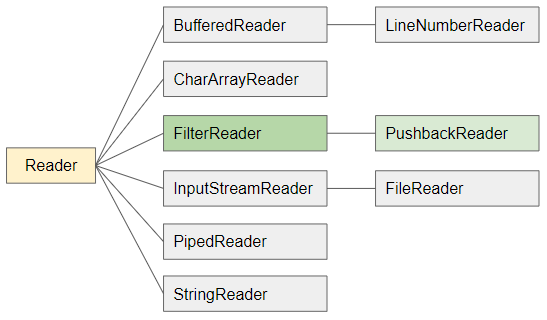Java FilterReader Tutorial with Examples
1. FilterReader
FilterReader is an abstract subclass of Reader class, which is the base class to create subclasses to selectively read required characters. For example, you want to read a HTML document, and ignore tags. You need to write a subclass of FilterReader, you cannot use FilterReader directly because it is an abstract class.

FilterReader does not directly read data from the origin (eg file) but it manages another Reader that is responsible for reading data from the origin. FilterReader selectively processes the data obtained from the Reader it manages.

A look at the source code of FilterReader class shows: All the methods that it inherits from the parent class have been overridden to act as a delegate of the Reader object it manages:
FilterReader class
package java.io;
public abstract class FilterReader extends Reader {
protected Reader in;
protected FilterReader(Reader in) {
super(in);
this.in = in;
}
public int read() throws IOException {
return in.read();
}
public int read(char cbuf[], int off, int len) throws IOException {
return in.read(cbuf, off, len);
}
public long skip(long n) throws IOException {
return in.skip(n);
}
public boolean ready() throws IOException {
return in.ready();
}
public boolean markSupported() {
return in.markSupported();
}
public void mark(int readAheadLimit) throws IOException {
in.mark(readAheadLimit);
}
public void reset() throws IOException {
in.reset();
}
public void close() throws IOException {
in.close();
}
}FilterReader constructors
protected FilterReader(Reader in)2. Examples
Example: Write a subclass of FilterReader to read HTML text but ignore tags.
RemoveHtmlTagReader.java
package org.o7planning.filterreader.ex;
import java.io.FilterReader;
import java.io.IOException;
import java.io.Reader;
public class RemoveHtmlTagReader extends FilterReader {
private boolean intag = false;
public RemoveHtmlTagReader(Reader in) {
super(in);
}
// We override this method.
// The principle will be:
// Read only characters outside of the tags.
@Override
public int read(char[] buf, int from, int len) throws IOException {
int charCount = 0;
while (charCount == 0) {
charCount = super.read(buf, from, len);
if (charCount == -1) {
// Ends of
return -1;
}
int last = from;
for (int i = from; i < from + charCount; i++) {
// If not in tag
if (!this.intag) {
if (buf[i] == '<') {
this.intag = true;
} else {
buf[last++] = buf[i];
}
} else if (buf[i] == '>') {
this.intag = false;
}
}
charCount = last - from;
}
return charCount;
}
// Also need to override this method.
@Override
public int read() throws IOException {
char[] buf = new char[1];
int result = read(buf, 0, 1);
if (result == -1) {
return -1;
} else {
return (int) buf[0];
}
}
}RemoveHtmlTagTest.java
package org.o7planning.filterreader.ex;
import java.io.BufferedReader;
import java.io.IOException;
import java.io.Reader;
import java.io.StringReader;
public class RemoveHtmlTagTest {
public static void main(String[] args) throws IOException {
// Create a Reader.
Reader in = new StringReader("<h1>Hello \n <b>World</b><h1>");
RemoveHtmlTagReader filterReader = new RemoveHtmlTagReader(in);
BufferedReader br = new BufferedReader(filterReader);
String s = null;
while ((s = br.readLine()) != null) {
System.out.println(s);
}
br.close();
}
}Output:
Hello
WorldJava IO Tutorials
- Java CharArrayWriter Tutorial with Examples
- Java FilterReader Tutorial with Examples
- Java FilterWriter Tutorial with Examples
- Java PrintStream Tutorial with Examples
- Java BufferedReader Tutorial with Examples
- Java BufferedWriter Tutorial with Examples
- Java StringReader Tutorial with Examples
- Java StringWriter Tutorial with Examples
- Java PipedReader Tutorial with Examples
- Java LineNumberReader Tutorial with Examples
- Java PrintWriter Tutorial with Examples
- Java IO Binary Streams Tutorial with Examples
- Java IO Character Streams Tutorial with Examples
- Java BufferedOutputStream Tutorial with Examples
- Java ByteArrayOutputStream Tutorial with Examples
- Java DataOutputStream Tutorial with Examples
- Java PipedInputStream Tutorial with Examples
- Java OutputStream Tutorial with Examples
- Java ObjectOutputStream Tutorial with Examples
- Java PushbackInputStream Tutorial with Examples
- Java SequenceInputStream Tutorial with Examples
- Java BufferedInputStream Tutorial with Examples
- Java Reader Tutorial with Examples
- Java Writer Tutorial with Examples
- Java FileReader Tutorial with Examples
- Java FileWriter Tutorial with Examples
- Java CharArrayReader Tutorial with Examples
- Java ByteArrayInputStream Tutorial with Examples
- Java DataInputStream Tutorial with Examples
- Java ObjectInputStream Tutorial with Examples
- Java InputStreamReader Tutorial with Examples
- Java OutputStreamWriter Tutorial with Examples
- Java InputStream Tutorial with Examples
- Java FileInputStream Tutorial with Examples
Show More